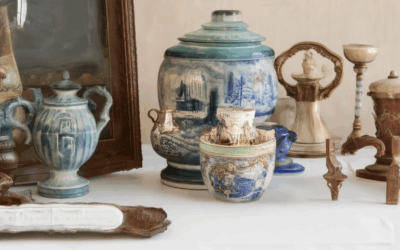Exploring the intricate details of vintage furniture styles offers a fascinating journey into the past, allowing us to connect with historical artifacts that tell stories of craftsmanship and cultural evolution. From the elegant lines of the Hepplewhite chair to the bold geometric patterns of mid-century modern designs, each piece carries its own unique story. Whether you’re a seasoned collector or a curious enthusiast, understanding how to identify these styles can transform your appreciation for these timeless creations. In this comprehensive guide, we delve into the secrets of recognizing vintage furniture, leveraging tools like Google Lens, and uncovering the best practices for preserving these treasures. Join us as we embark on a journey to decode the past and celebrate the artistry of antique designs.
Key Takeaways
– Reliable Apps for Identifying Vintage Furniture: Utilize apps like Retro Sales, Poshmark, eBay Motors, and Etsy to easily identify and value vintage furniture.
– Leverage Google Lens for Antique Identification: Use Google Lens to recognize styles, gather historical context, and compare items for enhanced antique identification.
– Top Tools for Wood Type Identification: Employ apps such as iNaturalist, WoodID, and Species Finder to accurately identify wood types, aiding in restoration and purchasing decisions.

Understanding the 100-Year Rule for Antiques
The term “antique” typically refers to items that are at least 100 years old and are in original, unaltered condition. This rule has been commonly accepted for most collectible items, though exceptions exist depending on the type of object.
Exceptions to the Rule
- Motor Vehicles: Some definitions allow automobiles to be considered antiques at just 25 years old. This is due to the rapid pace of technological advancements in the automotive industry.
- Cultural and Historical Significance: Items that hold special cultural or historical value may be considered antiques regardless of their age, though this is less common.
Applying the Rule
For most objects, the 100-year rule remains a standard criterion. Here are some examples:
- Furniture: A piece dating back to the late 1800s or early 1900s would likely qualify as an antique.
- Jewelry: Items from the Art Deco era (early 20th century) or earlier are often classified as antiques.
- Books: First editions from the 19th century or earlier are considered antiques.
Modern vs. Antique
Items from the last 100-150 years are generally considered too recent to be classified as antiques. Modern designs and technologies often set these apart from true antiquities.
Preserving Antiquity
When evaluating an item as an antique, condition is crucial. Original, undamaged pieces are preferred, though some restorations may still qualify depending on the item’s historical significance.
Collecting with Care
For those interested in building a vintage collection, platforms like Retro Sales offer a curated selection of rare and unique items. Explore our collection to discover pieces that tell the story of yesterday.
Remember, the 100-year rule is a guideline, and the true value of an item often lies in its history, craftsmanship, and cultural impact. Happy hunting!
How to Identify Vintage Furniture Styles
To identify vintage furniture styles, consider the following key characteristics:
- Age and History: Look for signs of wear and tear that tell a story of years gone by. Vintage furniture often shows signs of age gracefully.
- Materials: Natural materials like wood, metal, or leather are common in vintage pieces. These materials may have imperfections or a unique patina.
- Construction: Handcrafted details and sturdy, overbuilt joints are typical of vintage furniture. Modern mass-produced pieces may lack this quality.
- Decorative Elements: Intricate carvings, ornate details, and unique hardware can hint at a vintage style. These details often reflect the design trends of their time.
- Color and Finish: Rich colors and finishes with a patina may indicate age. Distressed finishes, like those seen on antique pieces, can also be a clue.
- Provenance: Knowing the history of a piece, such as its maker or previous owners, can help authenticate its vintage status. Look for labels or markings that provide insight into its origins.
- Historical Influences: Compare the piece to known historical styles, such as Art Deco, Mid-Century Modern, or Victorian, to determine its era and design influence.
- Condition: Examine the overall condition. Vintage furniture may show wear, but excessive damage or uniformity in wear can suggest restoration rather than true vintage status. Look for original finishes and untouched surfaces.
- Unique Features: Check for features that don’t align with current design trends, such as proportions or designs that haven’t been replicated in recent times.
By focusing on these elements, you can better discern whether a piece of furniture carries the charm and history of a bygone era.

How to Identify Your Antiques
To determine if an item is an antique, consider the following steps:
- Maker’s Mark: Look for markings under the item or in hidden areas. These marks can indicate the maker and origin, helping to estimate age.
- Material and Craftsmanship: Examine the quality of materials and craftsmanship. Older pieces may show signs of hand-made techniques or less refined methods.
- Design Trends: Compare the item’s style to historical design movements. Distinctive styles like mid-century modern or Victorian can hint at age.
- Wear and Tear: Assess the condition. Antiques often show more wear due to historical usage patterns.
- Restoration Signs: Check for evidence of repairs or restorations. Older items may have visible fixes from past restorations.
For further assistance, consider:
- Retro Sales Marketplace: List your items on our platform to connect with vintage enthusiasts and professionals.
- Blog Resources: Explore our blog for insights on retro culture and vintage trends.
- Community Forums: Engage with knowledgeable collectors and experts in online communities.
- Expert Appraisal: Consult with a professional authenticator for a detailed assessment.
Visit Retro Sales to explore our curated collection and learn more about identifying and valuing vintage items.

Is There an App for Identifying Antique Furniture?
Yes, there are several apps and platforms designed to help identify and value antique furniture. One popular option is Retro Sales , which offers a curated marketplace for vintage enthusiasts. Their app provides detailed descriptions and historical context for various pieces, helping users identify authentic antiques.
Another excellent tool is Poshmark , which focuses on vintage and antique items. The app allows users to browse listings, compare prices, and even learn about the history of the pieces they’re interested in.
If you’re looking for a more specialized experience, consider eBay Motors , which has a dedicated section for vintage and classic furniture. The app also offers valuation tools and community forums where users share knowledge and tips.
Additionally, Etsy has a vast selection of antique furniture pieces, and their mobile app provides detailed product descriptions and seller ratings to help you find authentic items. Lastly, Chairish is another great app for discovering and purchasing vintage furniture, with a user-friendly interface and helpful community features.
Can Google Lens Identify Antiques?
Google Lens is a powerful tool that leverages advanced image recognition technology to analyze and understand visual content. While it primarily excels in identifying objects, landmarks, and artistic styles, its ability to recognize details in images can be beneficial for certain tasks related to antiques.
Here’s how Google Lens can assist in identifying antiques:
- Object Recognition : Google Lens can analyze images of artifacts, furniture, or other items to identify their type, style, and sometimes even their historical significance. For example, it can recognize patterns, materials, and design elements that are characteristic of certain periods or cultures.
- Historical Context : By comparing images to vast databases of historical and cultural artifacts, Google Lens can provide insights into the age, origin, and cultural background of an item. This can be particularly useful for verifying the authenticity of antiques or determining their provenance.
- Comparison with Similar Items : The tool can compare the image of an antique with millions of other images in its database, helping users identify matching pieces, similar styles, or related items.
- Enhanced Search : Users can use Google Lens to search for similar items online, which can lead to discovering sellers, auction listings, or valuable resources for purchasing or learning more about the piece.
While Google Lens is not perfect for every aspect of identifying antiques, it serves as a helpful supplement to traditional methods like manual appraisal or consulting with experts. For serious collectors or researchers, it can save time by quickly narrowing down possibilities based on visual details.
For more information on leveraging Google Lens for antiques, visit our resource page .

Identifying Wood Types in Furniture
Are you looking for an app to help identify the type of wood used in furniture? There are several tools and apps available that can assist you in determining the species of wood. Below is a breakdown of popular options along with their features and how they can help you achieve your goal.
One of the most effective ways to identify wood types is by using specialized apps designed for this purpose. These apps utilize advanced algorithms and databases to match images of wood samples to their respective species.
- iNaturalist – This app is widely used by professionals and enthusiasts alike. It allows you to upload a photo of the wood you’re trying to identify and provides instant results based on its visual characteristics and location data.
- WoodID – Another excellent option, WoodID uses a combination of image recognition and database lookup to identify wood species accurately. It’s particularly useful for professionals in the woodworking or antiques trade.
- Species Finder – This app focuses on providing detailed information about various tree species, including their common names, scientific names, and distribution ranges. While primarily aimed at tree identification, it can also be useful for understanding the types of wood commonly found in furniture.
- Forest Finder – This app is geared towards helping users identify trees in their local area. It provides detailed descriptions and high-quality images of tree species, which can be helpful for understanding the wood types used in nearby furniture pieces.
When choosing an app, consider factors such as:
- Budget – Some apps may require a subscription or one-time purchase fee.
- – Look for apps with intuitive interfaces and robust search functionalities.
- – Ensure the app has a strong reputation for providing reliable identifications.
By leveraging these apps, you can gain valuable insights into the types of wood used in furniture, aiding in restoration projects, purchasing decisions, or simply satisfying your curiosity about the materials involved.
Conclusion
If you’re looking for a reliable app to identify wood types in furniture, we recommend starting with iNaturalist for its user-friendly interface and extensive database. For more advanced users, WoodID offers professional-grade accuracy. Choose the option that best fits your needs and preferences to get the most out of your experience.




0 Comments